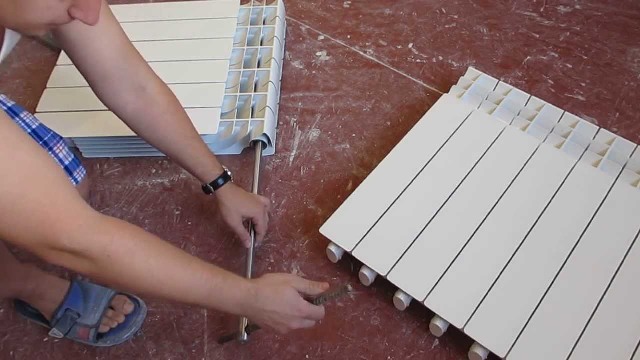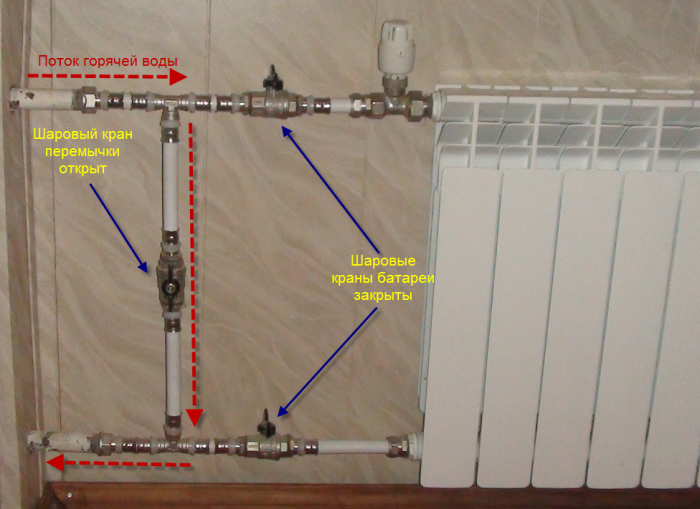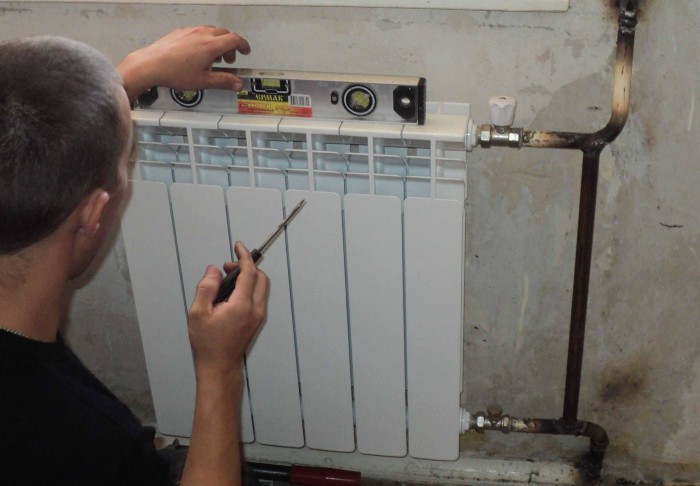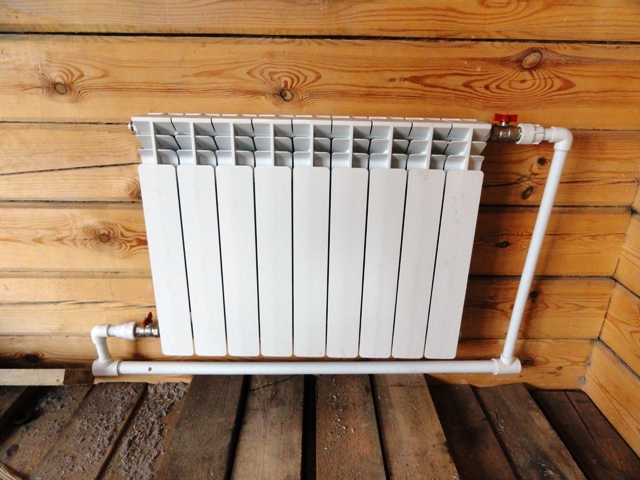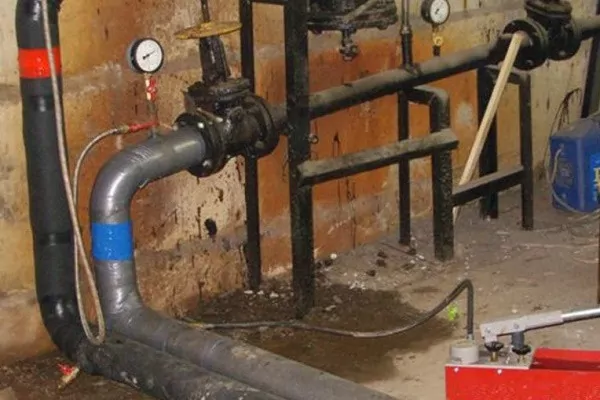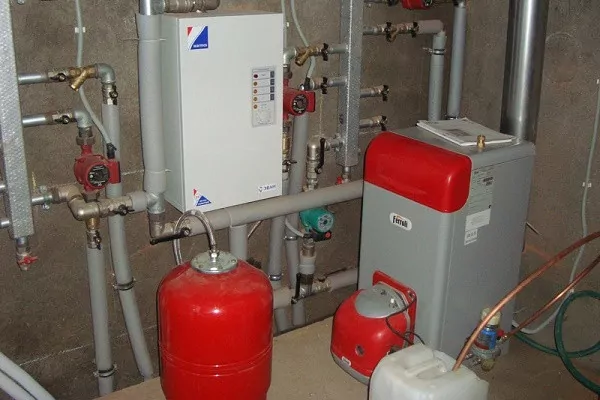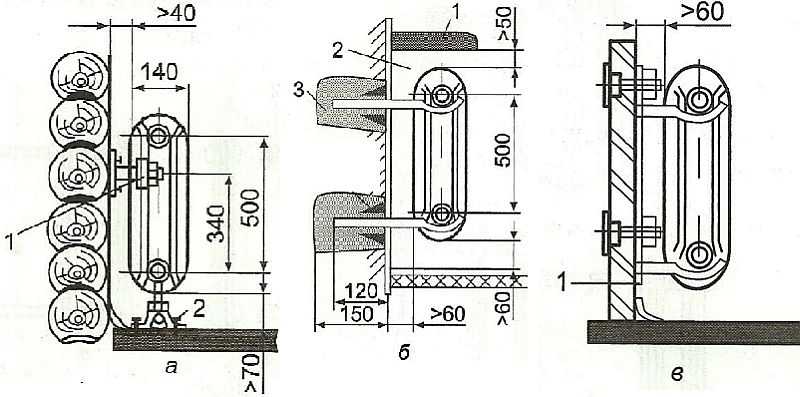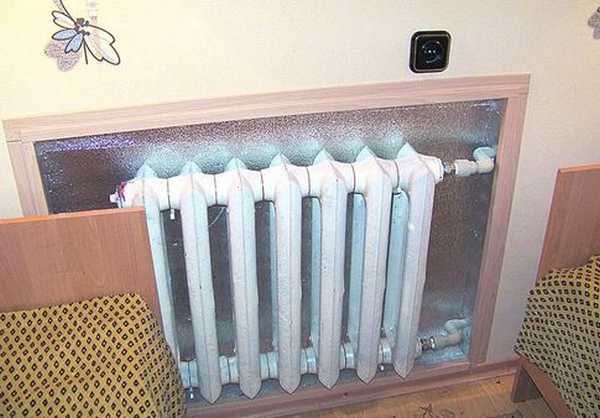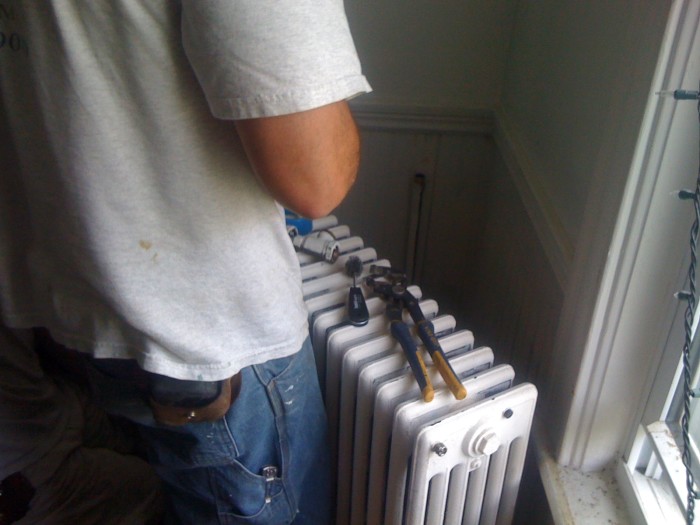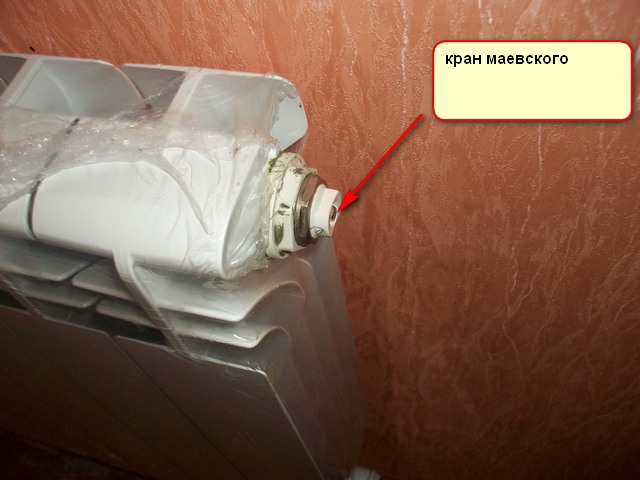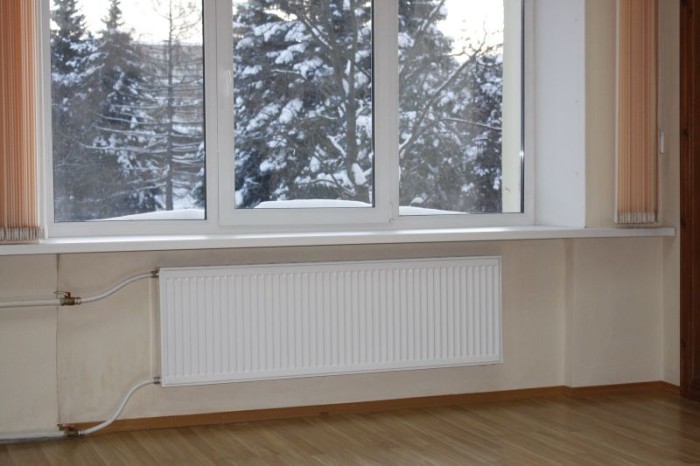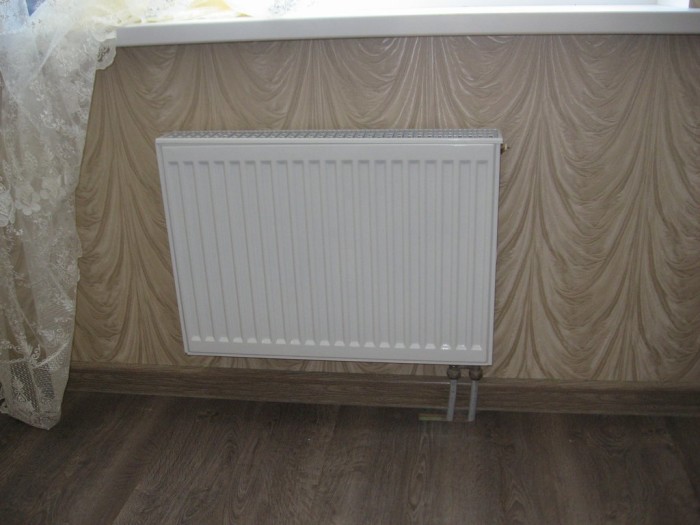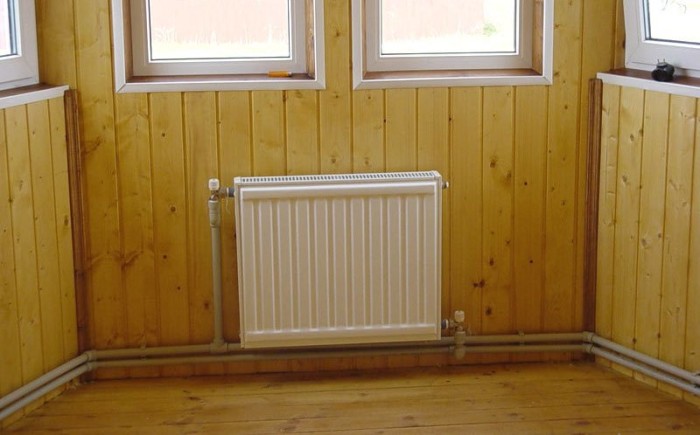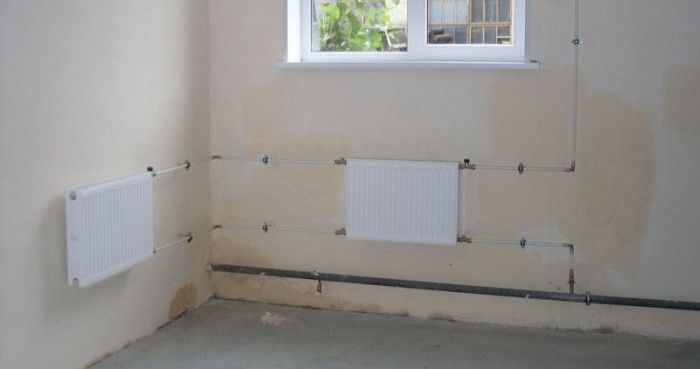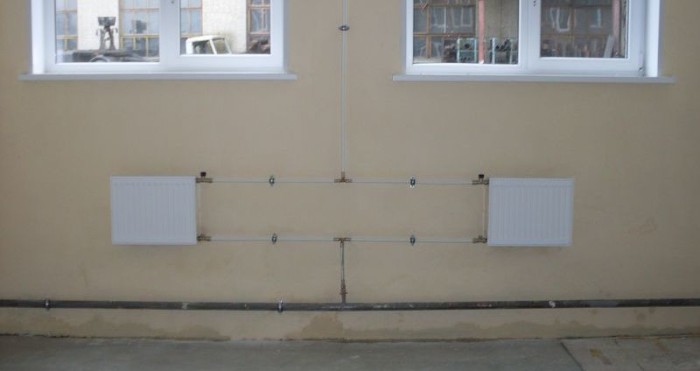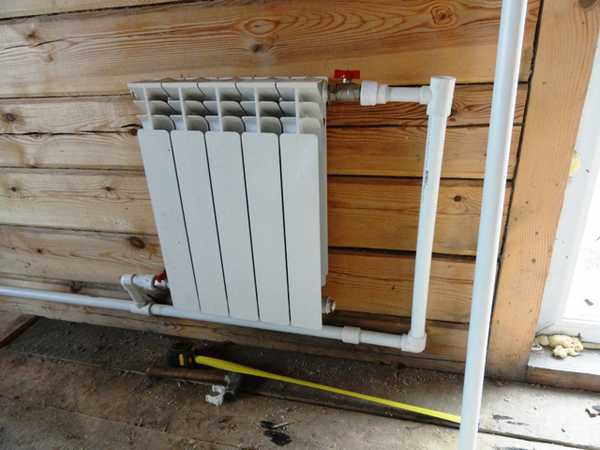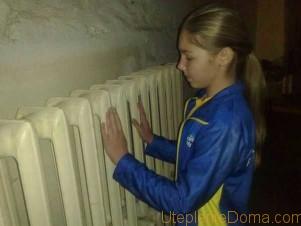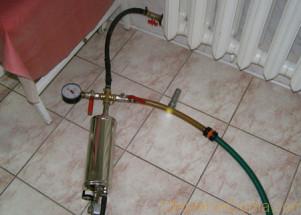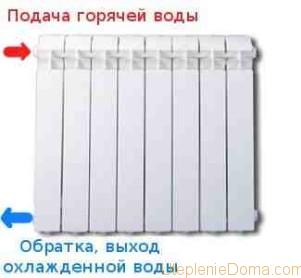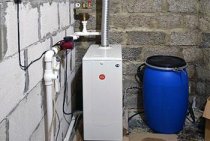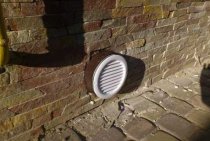Is assembly required
If the radiators are supplied assembled, it is enough to install the plugs and the Mayevsky crane. Most models have four holes located at the four corners of the case. They are used to connect heating lines. In this case, any scheme can be implemented.
Before the installation of the system begins, it is necessary to close the extra holes using special plugs or air vent valves. The batteries are supplied with adapters that must be screwed into the manifolds of the product. Various communications should be connected to these adapters in the future.
prefabricated models
Assembling the batteries should begin with laying the entire product or its sections on a flat surface. Best on the floor. Before this stage, it is worth deciding how many sections will be installed. There are rules that allow you to determine the optimal amount.
The sections are connected using nipples with two external threads: right and left, as well as a turnkey ledge. The nipples should be screwed into two blocks: top and bottom.
When assembling the radiator, be sure to use the gaskets supplied with the product.
It is necessary to ensure that the upper edges of the sections are correctly located - in the same plane. The tolerance is 3 mm.
Work sequence
Installation of batteries begins with a complete overlap of the circuit. When replacing old radiators with new ones, water is drained and the heating elements are dismantled. It will be correct to use the pump to exclude the presence of coolant residues in the system.
After all the water has been removed, the battery attachment points are aligned in both planes. Brackets are installed.
The next step will be the packaging of radiators using sealing linen, packaging paste or special shut-off valves. Using a torque wrench, tighten the connection, creating the force specified in the documentation.
Installation work
Installation of radiators on the wall is carried out by welding or polypropylene pipes. In the first case, it is enough to use two fasteners; in the second, at least three are required. Two should be at the top, one at the bottom.
With ten or more sections, the number of fasteners should be increased to five. There should be three at the top, two at the bottom.
Spatial control
The position of the batteries in both planes is monitored. It is advisable to provide a slight slope towards the wall. This will avoid airing the system during its operation.
The final stage
Threading is performed on the risers and the connection of all elements of the heating system. The tightness of all connections is carefully controlled.
After that, trial tests can be carried out in order to detect a possible leak.
If until now everything has been done by hand, at this stage it is better to invite a ZHREU locksmith. By shutting off the taps of the "American", you can open the connecting tap. It is better to entrust the opening of the return pipe to a locksmith.
If there are no leaks at the connection points, it will be possible to open the valve on the batteries and close the bypass valve. The coolant will begin to flow into the heating system. To bleed air, you should use the Mayevsky crane.
As soon as the heating circuit in all rooms warms up, the locksmith will open the straight pipe. This will restore pressure in the system. We can assume that the control tests are completed. If the installation was done correctly, the apartment will be comfortable at minimal cost.
Signs of poor heating system maintenance
For the normal functionality of the heating system, nothing should interfere with the movement of the coolant through the channels built for it.
There are several symptoms that a large amount of debris has accumulated inside the heating circuit, and scale has settled on the walls of the pipes. There are no obvious visual signs of clogging of the heating system.
You can diagnose it by carefully monitoring the operation of the entire system and the appearance of a number of indirect signs:
- warming up the system takes longer than before (for autonomous heating systems);
- the operation of the boiler is accompanied by sounds uncharacteristic for it;
- increased consumption of gas or electricity; the temperature in different parts of the radiators varies significantly;
- radiators are noticeably cooler than supply pipes.
However, weak or uneven heating of the batteries is not always a sign of clogging. Perhaps they were airing. In such a situation, it is enough to release the air lock through the Mayevsky crane.
In houses with a centralized heating system, flushing must be carried out by employees of the heating company. In a private house, this procedure is carried out by the owners or invited specialists.
It is difficult to unequivocally recommend the frequency of flushing the system. Too many factors go into this.
So, for example, in centralized heating systems, the coolant must go through a water treatment cycle, which reduces the degree of pollution. True, this rule is not always followed. And the system itself is often in operation for the third or fourth decade, and the amount of garbage circulating inside increases every year.
But for both centralized networks and autonomous systems, it is recommended to flush annually. Which, by the way, is confirmed by the requirements of building codes. It is this period that is considered critical for the accumulation of the amount of debris inside the circuit, which significantly reduces the efficiency of work.
Rules for installing heating radiators
Length requirements are far from all recommendations. There are also rules for the location under the window relative to the floor, window sill and wall:
- It is required to place the heater strictly in the middle of the window opening. When installing, find the middle, mark it. Then right and left set aside the distance to the location of the fasteners.
- The distance from the floor is 8-14 cm. If you do less, it will be difficult to clean, if more, cold air zones form below.
- The radiator should be 10-12 cm from the window sill. With a closer location, convection worsens, and the thermal power drops.
- The distance from the wall to the back wall should be 3-5 cm. This gap ensures normal convection and heat distribution. And one more thing: at a small distance, dust will settle on the wall.
Based on these requirements, determine the most suitable size of the radiator, and then look for a model that satisfies them.
Mounting methods depending on the type of wall
These are general rules. Some manufacturers have their own recommendations. And take it as advice: before buying, carefully study the installation requirements. Make sure that all conditions suit you. Only after that buy.
To reduce non-production losses - for heating the wall - fasten a foil or foil thin heat insulator behind the radiator on the wall. Such a simple measure will save 10-15% on heating. This is how heat transfer increases. But keep in mind that for normal “work”, there must be a distance of at least 2-3 cm from the shiny surface to the rear wall of the radiator. Therefore, the heat insulator or foil must be fixed to the wall, and not just leaned against the battery.
When should radiators be installed? At what stage of the installation of the system? When using radiators with side connection, you can first hang them, then proceed with the piping. For the bottom connection, the picture is different: you only need to know the center distance of the nozzles.In this case, radiators can be installed after the repair is completed.
Attach foil to the wall to increase heat output
Features of installation of various types
The material from which a particular heating element is made imposes certain requirements on its installation. If cast iron is not afraid of serious mechanical stress, then others require special care.
Cast iron classic
Cast iron radiators are still relevant. The special characteristics of the material used in their manufacture make it possible to effectively heat a room of any area due to slow cooling.
To install such a heating element correctly, before connecting, you should:
- disassemble the finished product into sections;
- stretching all the nipples, assemble the product in reverse order.
When performing installation work, it is worth considering the weight of the product and the composition of the material from which the house was built. The heating element can only be mounted on brick and concrete walls. Installing the battery near a drywall wall is done on a floor stand.
Modern models
Such products are characterized by low weight and increased fragility. For them, it is necessary to provide a Mayevsky crane.
In the process of performing installation work, do not remove the packaging to prevent deformation of the surface.
Best Answers
President of Russia:
To put it simply: Industrial water is water used by enterprises for technological purposes. Its difference from drinking water is that the requirements for impurities and bacteria for drinking water are higher than for technical water. Example. Industrial water - water in heating systems. This water contains various technological impurities. For this water, sewage and sewage waters after their technical purification can be used (bacteriological purification is also possible, as well as special chemical compositions to prevent defrosting of heating systems. It is not allowed to use industrial water as drinking water and for contact with food and other human activities. If use and is allowed, for irrigation, flushing (sewerage), then a chemical and bacteriological analysis of this water must be carried out. Non-chlorinated industrial water at temperatures from 20 to 40 degrees is of particular danger. All bacteria actively develop in this water - deadly to human life. Swimming in such water is deadly, as infection with tuberculosis, dysentery, meningitis, etc. is possible.
Kenshi Hemuro:
Tell us in more detail what kind of industrial water? Either way, don't drink it.
Evgeny Zemenkov Larisa Blikova:
Lived in a rented house. The water was very hard from the well. Dropped the car. Filters have been changed twice in six months. Now, I think, they are all taps there, they throw out mixers.
MamaIra:
We have hot technical water flowing from the tap, of course you can’t drink it, but you are welcome to wash and wash it.
Echidna:
I don't think you have a choice. You will not filter the water separately for each wash.
valery ivanov:
if technical water is groundwater, then in this one you can do anything
NICOLE:
and we drink at work, we only boil in advance
Installation of radiators
Connection diagrams for heating radiators.
Before starting work, you need to make a complete shutdown of the heating circuit, then drain the water from the system, carefully remove the remnants of which the pump can help. Qualitatively check with the help of a level a radiator hung on supports horizontally and vertically.
Remove all plugs from the device. A bypass equipped with a valve is connected, which is required only for a one-pipe circuit. A bypass is not required to connect to a two-pipe circuit; only a squeegee with a valve connected to it is used for connection.With the help of threaded rods, a radiator is connected to the system; tow or other sealant is used to seal the joints.
The installation is complete, but a proper crimping is still required. To carry it out, you will need to call a plumber. And it makes no sense to buy a device for the sake of installing several batteries. How to install a cast iron battery?
Assembly diagram of heating radiators.
The material, which is not pleasing with elegance, retains heat for a long time and gradually transfers it to the heated space. For those who want to know how to properly install a heating radiator, which is made of heat-intensive cast iron, the specific design features of the device and its installation are described here:
before installation, the cast iron radiator must be unscrewed, the nipples adjusted, and then the radiator must be reassembled. Disassembly is done on a workbench using a pair of radiator wrenches that are inserted into the nipple holes. In order to increase the applied force and to fix it, a crowbar is inserted into the eye of the key, which is designed to unscrew the lower nipple. In order to avoid distortion, both nipples, which are located at the top and bottom, unscrew at the same time. Work will be more convenient to do together
When unscrewing a cast iron radiator, attention must be paid to the direction of the thread. On different sides of the cast iron radiator, the thread has the opposite direction.
Next, remove the section;
by analogy, it is necessary to unscrew all the sections, and then, in strictly reverse order, you need to correctly group them into a single device with the required number of sections for heating the room. The assembled battery is pressure tested, if a leak is detected, the nipple is adjusted in the problem area;
wall-mounted cast iron radiators are fixed on brick and foam concrete walls. Wooden walls cannot support the weight, so the owner of a wooden house will need to supply batteries with special floor supports. But it is also necessary to install supporting fasteners on the walls;
since in private houses the heating is mainly single-pipe, it is necessary to install a bypass. In the connection diagram, it is necessary to install the Mayevsky crane and the corresponding shutoff valves;
connection to the pipeline is carried out using threaded spurs. In wooden buildings, it is better not to use a welding machine.
There is not a single particularly difficult moment in the installation technology. If you strictly follow the sequence, know the rules, study the information on how to properly install a heating radiator. then you can safely get down to business with hands that confidently hold radiator, torque wrenches and other tools. But confidence alone is not enough to achieve success. Thorough observance of the installation rules and the formation of impeccable tightness, which guarantees the complete absence of leaks, will definitely help.
How will we connect
The scheme for connecting radiators can be different. The level of heat transfer and the comfort of being in the apartment depend on which option will be preferred. Incorrectly selected wiring can reduce the power of the heating system by 50%.
The most widespread is the one-sided side scheme, which has the highest heat transfer rate. In this case, the pipe supplying the coolant is connected to the upper branch pipe, and the outlet pipe to the lower one.
If you do the opposite, the efficiency of space heating will decrease by almost 7%. To connect multi-section radiators, such a scheme is not always justified, since insufficient heating of the last sections is possible. This can be avoided by installing a water flow extension.
In an apartment with pipes hidden in the floor or passing under the plinth, a bottom connection is used.
This is the most aesthetic option, in which the pipes for supplying and discharging the coolant are located below in the floor, and therefore the lower holes are used for connection.
Diagonal
Installation of batteries with twelve or more sections is carried out in a diagonal pattern.
The coolant is supplied through the upper branch pipe located on one side of the radiator, and is discharged through the lower one on the other side.
Sequential
Such a connection scheme assumes the presence in the heating system of pressure sufficient for the movement of the coolant through the pipes.
In this case, it is worthwhile to provide for a Mayevsky crane, designed to remove excess air.
It is important to remember that the implementation of repair and maintenance work will be accompanied by a shutdown of the entire heating system.
Parallel
Parallel wiring assumes the presence of a special heat pipe built into the heating system, through which the coolant is supplied and discharged outside.
The presence of special taps at the inlet and outlet makes it possible to replace individual radiators without turning off the heat supply. However, the scheme can cause insufficient heating of the pipes at reduced pressure in the system.
How to place batteries
First of all, the recommendations relate to the installation site. Most often, heaters are placed where heat loss is most significant. And first of all, these are windows. Even with modern energy-saving double-glazed windows, it is in these places that the most heat is lost. What can we say about the old wooden frames.
It is important to correctly place the radiator and not make a mistake in choosing its size: not only power is important
If there is no radiator under the window, then cold air descends along the wall and spreads across the floor. The situation is changed by installing a battery: warm air, rising up, prevents cold air from “draining” onto the floor. It must be remembered that in order for such protection to be effective, the radiator must occupy at least 70% of the width of the window. This norm is spelled out in SNiP. Therefore, when choosing radiators, keep in mind that a small radiator under the window will not provide the proper level of comfort. In this case, there will be zones on the sides where cold air will go down, there will be cold zones on the floor. At the same time, the window can often “sweat”, on the walls in the place where warm and cold air will collide, condensation will fall out, and dampness will appear.
For this reason, do not seek to find a model with the highest heat dissipation. This is justified only for regions with a very harsh climate. But in the north, even of the most powerful sections, there are large radiators. For the middle zone of Russia, an average heat transfer is required, for the southern ones, low radiators are generally needed (with a small center distance). This is the only way you can fulfill the key rule for installing batteries: block most of the window opening.
The battery installed near the doors will work effectively
In cold climates, it makes sense to arrange a thermal curtain near the front door. This is the second problem area, but it is more typical for private houses. This problem may occur in the apartments of the first floors. Here the rules are simple: you need to put the radiator as close to the door as possible. Choose a place depending on the layout, also taking into account the possibility of piping.
It is forbidden to take water from batteries and it is harmful to health
- Details
- Created on 06/06/2017
We do not have centralized hot water supply as such, because we have an open heat supply system, that is, there is no separate boiler in the boiler room and a separate pipeline for hot water. An open hot water supply (heat supply) system is understood as a technologically connected complex of engineering structures designed for heat supply and hot water supply, carried out by taking hot water from the heating network. Once again I want to remind users of heat supply services that, in accordance with paragraph 35 of Decree of the Government of the Russian Federation dated 06.05.2011 No. 354 “On the provision of utilities to owners and users of premises in apartment buildings and residential buildings” It is strictly forbidden to use hot water from the heating system. Resource-supplying organizations suffer losses due to unauthorized water analysis.requires constant feeding of boilers with cold water and additional fuel consumption for heating the coolant. According to this resolution, the Consumer is not entitled to: b) drain the coolant from the heating system without the permission of the contractor; c) to arbitrarily dismantle or turn off the heating elements provided for by the design and (or) technical documentation for an apartment or residential building, to arbitrarily increase the heating surfaces of heating devices installed in a residential building in excess of the parameters provided for by the design and (or) technical documentation for an apartment or residential building House; d) arbitrarily break the seals on the metering devices and in the places of their connection (attachment), dismantle the metering devices and carry out unauthorized interference in the operation of these metering devices; e) to regulate the intra-apartment equipment used for the consumption of the public heating service; f) unauthorizedly connect consumer equipment to in-house engineering systems or to centralized networks of engineering and technical support directly or bypassing metering devices, make changes to in-house engineering systems.
Therefore, the State Housing Inspectorate of the Republic of Khakassia recommends that owners of premises in apartment buildings that are not equipped with centralized hot water supply dismantle water taps on heating appliances and install electric water heaters. If, during the inspection of housing inspectors, the presence of additional equipment for draining water from the heating system is recorded, consumers face administrative liability for the illegal reconstruction of residential premises under Article 7.21 of the Code of Administrative Offenses of the Russian Federation in the form of a fine of up to 1,500 rubles. And one more important point, hot water supply must comply with the sanitary and epidemiological requirements for the quality of drinking water. DHW in an open system cannot meet the specified requirements, since the heat carrier in the heating system is process water. This is confirmed by the results of the analysis of water from the heating system, conducted by an accredited testing laboratory center on May 5 of this year. Here are some characteristics of battery water:
| Parameters (characteristics) | Actual performance | Regulatory indicators |
| Common coliform bacteria | 15 | Not allowed |
| thermotolerant coliform bacteria | 15 | Not allowed |
| Iron | 0,95 | Not more than 0.3 |
| Chroma | 75,2 | no more than 20 |
| Turbidity | 19,26 | No more than 1.5 |
Based on the foregoing, in order to avoid unauthorized analysis of water from the heating system and prevent harm to the health of citizens, a special dye will be added to the heating system, which can spoil the appearance of linen if washed with such water.
Labor protection engineer of Tashtypenergo LLC Yu. V. Bocharov
Features of installing radiators in an apartment
The above rules for the installation of heating radiators are common for both individual systems and centralized ones. But before installing new radiators in you must obtain permission from the management or maintenance company. The heating system is common property and all unauthorized alterations have consequences - administrative fines. The fact is that with a massive change in the parameters of the heating network (replacing pipes, radiators, installing thermostats, etc.), the system is unbalanced. This can lead to the fact that the entire riser (entrance) will freeze in winter. Therefore, all changes require approval.
Types of wiring and connection of radiators in apartments (click on the picture to enlarge it)
Another feature is technical in nature.With vertical single-pipe wiring (one pipe enters through the ceiling, enters the radiator, then exits and goes to the floor), when installing the radiator, install a bypass - a jumper between the supply and discharge pipelines. Paired with ball valves, this will give you the ability to turn off the radiator if you want (or in an accident). This does not require the approval or permission of the manager: you turned off your radiator, but the coolant continues to circulate through the riser through the bypass (the same jumper). You do not need to stop the system, pay for it, listen to neighbors' complaints.
A bypass is also needed when installing a radiator with a regulator in the apartment (the installation of the regulator also needs to be coordinated - it greatly changes the hydraulic resistance of the system). The peculiarity of his work is such that he blocks the flow of coolant. If there is no jumper, the entire riser is blocked. Imagine the consequences...
Do-it-yourself installation of heating radiators is not the easiest, but not the most difficult task. Just keep in mind that most manufacturers give guarantees only if the heaters are installed by representatives of organizations licensed for this. The fact of installation and pressure testing must be noted in the radiator passport, the signature of the installer and the seal of the enterprise must be. If you do not need a guarantee, your hands are in place, it is quite possible to handle it.
Expert answers
Andrew Su:
No. In heating systems, water moves in a closed circuit. There are no standards for its suitability for other uses, unlike the hot water that is supplied to the taps. The latter is technical and unsuitable for eating, but it is theoretically possible to use it for washing dishes and our bodies. Well, how things are going in your city with the observance of the relevant standards - this is another question.
Mayan:
No, it is technical, and sometimes there is some substance instead of water ...
Sokol Pasha:
ugh… now I understand why dyes were added there in some area….
Maria:
It seems that caustic soda is added there so that the batteries are not covered with lime with arr. sides. You can crawl.
Yagodkin:
There is, of course ... this is slop water .. although if you drive it away well ... then it’s quite ... Yes, okay, people don’t wash themselves with such water ..
Buka Byakina:
It contains technical salt to increase heat transfer! It is not recommended to use water from central heating batteries.
dead_dog:
In no case!!!! A very large number of different chemicals are added to the water for central heating, which increase the heat capacity of water and protect pipes from corrosion.
User deleted:
In my house, people on the top floor wash themselves from the battery.
Servant:
no, just drink
Nicolai Berescu:
No
balamut:
She almost answered herself. You won’t peel off right away, but with constant use it’s fraught with shitty consequences, precisely because of the impurities that are necessarily added to the water. (I will omit technical details)
Besenka:
And you check... on neighbors... unscrew the battery tap, make a flood, flood the neighbors. And then they will share the sharpness of sensations! And after a month of such experiments, go to them and check how boiling water worked on them. True, it is still dangerous ... for you.
Sonichka Sonkina:
it contains alkali, and it is harmful. You risk falling off.
Is@bell@:
you can wash it clean as a boiler.
Flent:
xs
Den 45:
it is possible to have hot water and heating from one boiler, only hot water is constantly skipped, but there is no heating.
Igor Belov:
I think it's theoretically possible. Another thing is that you will not be allowed to do it by any means .... one of them is a lie about the fact that there is not water there, but a special liquid and that it will burn your hands to the elbow. This is written by trolls from all sorts of zheks and management companies that feed on it. and there gigantic money is spinning for good reason housing and communal services in Russia are called a black hole.
A Pavlov:
a little expensive, but if there is no alternative, then you have to fork out for filters.it's from iron and just activated charcoal.
artem artem:
practically a holy spring, such water can be drunk even by infants.
Smirnova Hope:
I don’t even recommend washing the floors, and even more so the dishes and washing. grab something that's for sure
Version n:
You can't, but you have to
Ilya Muromets:
You can, and drink and wash, yellow because the pipes are rusty, and rust is not harmful to the body.
Drinker in the Blackthorn:
drilled new wells. built new sewage treatment plants. put water into people's homes. We decided to check the quality of the water. sent water for analysis to Germany. the answer came soon - you can wash yourself with water after passing it through the filter and boiling the water for at least 3 hours.
Lesya:
Set filters.
Aleh-:
General consumer filters, i.e., which can be purchased at retail, will not save you. They will not save anyone at all, this is pure marketing. A filter that will help is unlikely to be affordable for you. What kind of smell is observed? ? and where is the water supply, apartment, private house or maybe an office. Refine your question.
Alex Mishin:
In my wife’s old apartment, swamp slurry flowed from the taps: a five-story building in a village near Moscow stood in a swamp, the water intake was nearby. So what - live unwashed or go to the bathhouse? And washed and washed. For washing, water was passed through several layers of dense fabric before being poured into the washing machine, because fine polypropylene filters built into the water supply line were not yet sold. For this reason, they did not then buy an automatic washing machine, although they already were. Water for food purposes was used exclusively purchased, in bottles. In our current apartment, the water is also rusty - I put two identical filters for fine mechanical cleaning in a train in front of the washing machine, the second one in a transparent case, when it starts to turn brown, it means that it is necessary to replace the filter element in the first cascade. I bring drinking water from work from the tap - I trust Moscow tap water more than “bottled”, let these literate people first learn to distinguish between the concepts of “bottled” and “bottled”, that is, processed with some kind of butyl derivatives! ..
Why the batteries are cold and the riser is hot, experts explain
On cold batteries, do not warm your hands.
There can be a lot of reasons why the coolant supply pipe is hot and the radiator is cold. Specialists for general development name only the main ones:
- the central tap on the heat supply line is closed or the return line is closed;
- insufficient coolant flow;
- airing the system or a specific riser, radiator;
- the heating system is not balanced;
- pollution in the heating circuit;
- reduction in the cross section of the heat carrier supply pipe.
However, the following actions of the residents of the house will help the craftsmen who came to the call to quickly eliminate the malfunction of the heating circuit:
- it is necessary to install a hot pipe, and the radiator is cold in only one apartment, or this problem affects the entire riser. Perhaps the heating wiring of the entire entrance is faulty;
- does not interfere with going around all the entrances and seeing if the heating elements are hot there;
- you can go down to the basement and inspect the pipes for breakdown. Even a drip leak leads to a pressure drop in the system. This adversely affects her work.
All information received should be transferred to specialists. However, there are situations when the organization involved in the heat supply of the house refuses to repair the wiring. In this case, residents need to contact the regulatory authorities with a complaint about the poor quality of services provided. They also read: “Where to go if the batteries do not heat up?”.
Everything you need to know about filling the heating system with antifreeze can be found here.
Circuit cleaner.
If the batteries do not heat up the riser.If the riser is cold, the battery is cold - this is a sure sign that the main line through which the coolant flows is blocked. In confirmation of this, you need to walk through the neighboring apartments. They should warm up well. In this case, only a plumber can fix the breakdown, who will have drawings of the house heating wiring in his hands.
The next state of affairs, when the pipe is hot and the battery is cold, indicates a blockage in the system or the presence of an air lock. It prevents the penetration of the coolant into the heating element. From this, the latter does not warm up. Blockages are eliminated only if the radiator is completely disassembled and air under pressure is driven through it. This can only be done by a specialist who has the necessary tools and equipment.
It is easy to eliminate an airlock that interferes with the full circulation of the coolant in the system. To do this, each radiator is equipped with a Mayevsky crane. It is enough to open it and drain some hot water. With it, unnecessary air will also come out. They also read: “What to do if the batteries do not heat up?”.
All the nuances that you may encounter when installing an electric boiler in a heating system are described at this link.
If the radiators in the entire entrance do not heat
When the radiator is cold and the riser is hot, you need to pay attention to the pressure in the circuit. With insufficient pressure, the coolant cannot pass through all the radiators in the circuit
As a result, the batteries lower their temperature as they move away from the heat-carrying main. Residents of the house are not able to increase the pressure in the system on their own, and therefore it is recommended to seek help from professionals. More specifically, call the organization that is responsible for the heat supply of the building.
Supply and return can be interchanged.
Residents of a new house, when the heating system is first started, can observe the following situation when the battery is cold and the return is hot. Here it is appropriate to assume that errors were made during the installation of the heating elements. In this case, the pipes supplying the coolant and the return flow of the circuit are reversed. If we are talking about an individual heating circuit, then you should look at the circulation pump. It may not have been installed correctly.
When asked why there is a cold return in batteries, experts unequivocally point to an improperly designed heating system. In some cases, it is appropriate to talk about a small coolant flow rate.

